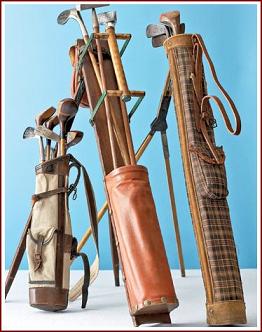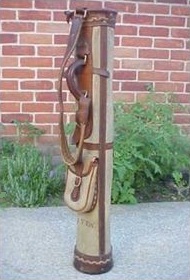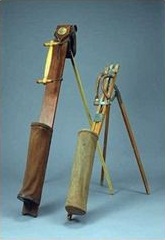Golf Bag History
 Golf
bag history includes the evolution of the golf bag as it needed to evolve in order to keep
up with the evolution of golf equipment and accessories.
Golf
bag history includes the evolution of the golf bag as it needed to evolve in order to keep
up with the evolution of golf equipment and accessories.
Today's golf bags include features that are selective to riding and walking.
They include compartments for all the modern toys and accessories that help us try to be more competitive in the game.
Check out our guides here for more information.
Antique Golf Bags For Sale
The History of Golf Bags and Golf Bag Features
Vintage Golf Bags
 Golf
Stand Bags – A Short History
Golf
Stand Bags – A Short History
Golf stand bags have come a long way since they were first invented
The Modern Golf stand bags are one of the most heavily developed golf bag products of recent years.
The modern stand bag was created in the late 70's early 1980's when manufacturer Sun Mountain introduced the first golf bag with retractable legs that extended automatically when you sat it down, now known as the golf stand bag.
The Advantages of Golf Stand Bags
- Light weight and durable
- No bending over to find your golf clubs
- Helps you save energy for your game
- Saves you time on the golf course
- Reduces the strain from picking up and putting down your golf bag
- Makes it easy to find, and get to your clubs and accessories
- Keeps your clubs dry in wet weather (when used with a hood)
Historians identify the golf bags' advent to be somewhere around the late 1800s
In the 1880s the first golf bags were introduced into the market. Early 1900s golf bags were made from canvas and leather with metal top and bottom protection areas. This simple style continued into the 1920s and '30s.
1940s-1980s
 After World War II, golf bags grew to be much roomier as they began to add comfort and
accessory features for storage space to house golf balls, gloves, tees and books.
After World War II, golf bags grew to be much roomier as they began to add comfort and
accessory features for storage space to house golf balls, gloves, tees and books.
These modern era bags incorporated lightweight materials such as plastic and nylon that allowed the addition of carrying straps, pockets, buckles and zippers for added dimension and functionality.
In the1950s the introduction of battery-powered golf carts initially reduced golf bag sales, so designers created cart-friendly golf bags with features that would prevent them from rolling out of the powered carts.
By the mid 1980's light weight golf bags for walking included kickstands and double straps as regular features to be more user friendly
1990s to Present
Today's high tech golf bags use plastics, polymers, nylon, metal compounds and leather. Pockets and compartments accommodate 14 golf clubs, cell phones, cameras, sport drinks, and even distance-measuring devices as well as the normal compartments for golf shoes, golf balls and accessories.
Over recent years the use of specialty clubs like fairway woods have increased the size of bags for including more club options on the course. The United States Golf Association Rule 4.4 stipulates that the maximum number of clubs allowed during competition is 14, and players face disqualification if their bag contains more.
Golf Bag Etiquette
Today in competition golf bag inspection is expected, as is the adherence to etiquette rulings about where to place your bag. The Professional Golfers Association handbook specifies that you never place your golf bag directly on the surface of any green.
Golf Travel Bags
Travel bags were also another product introduced for golfers who like to travel in order to be able to carry all their equipment and accessories in one bag that is self contained and attractive.
Many styles of golf bags have trended over the years as materials and patterns have changed or been personalized. Finding the best bag that golfers can use for traveling and carrying golf supplies on the green is just a matter of selection!
Cart Bags | Stand Bags | Travel Bags | Organizers | Head Covers
